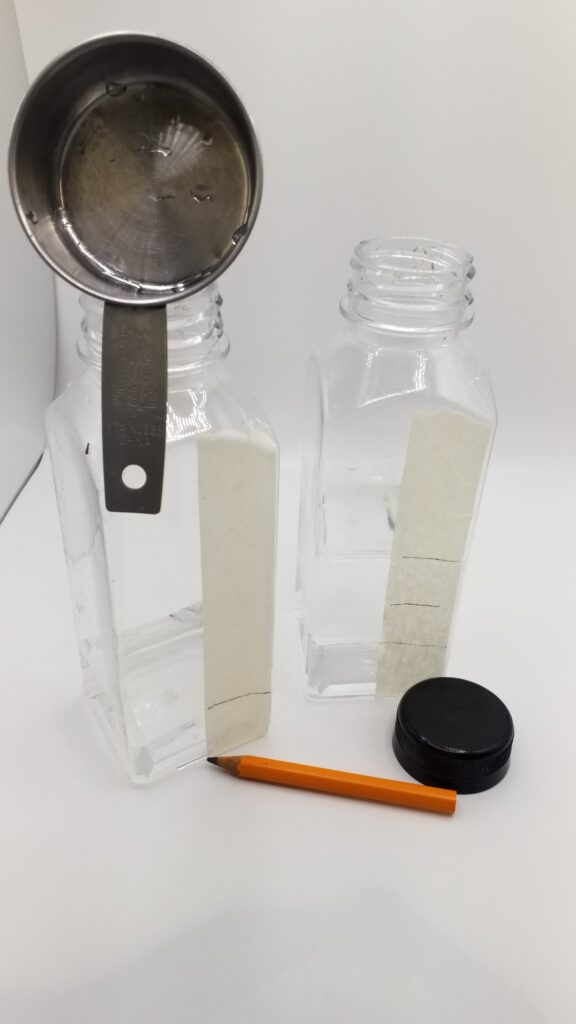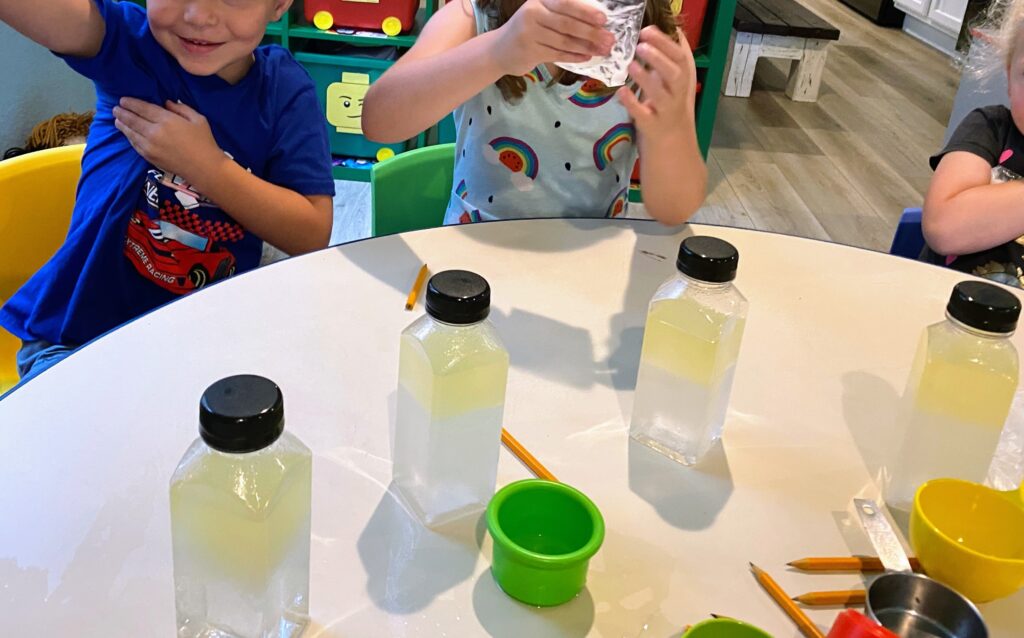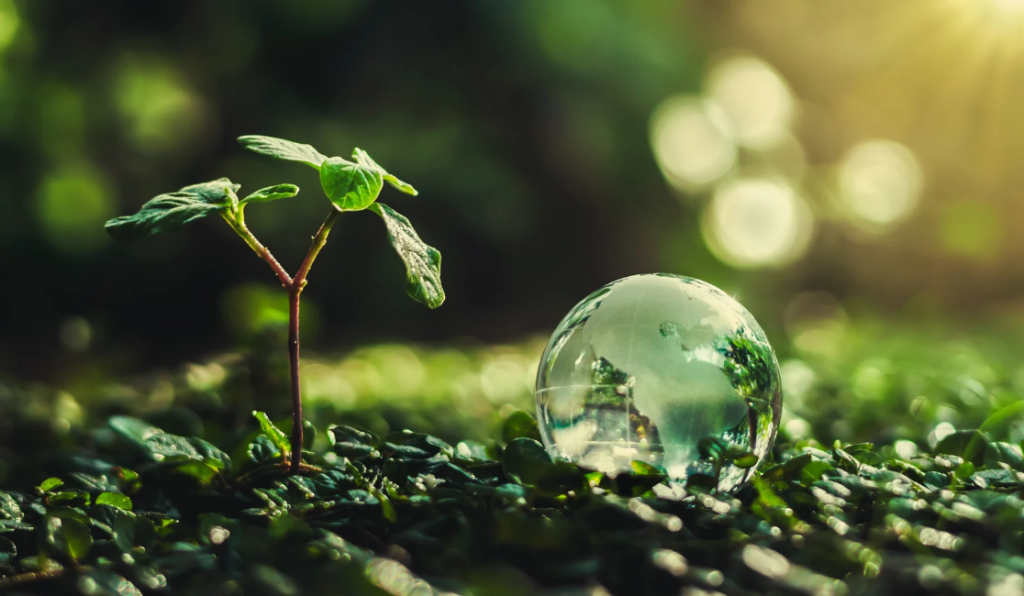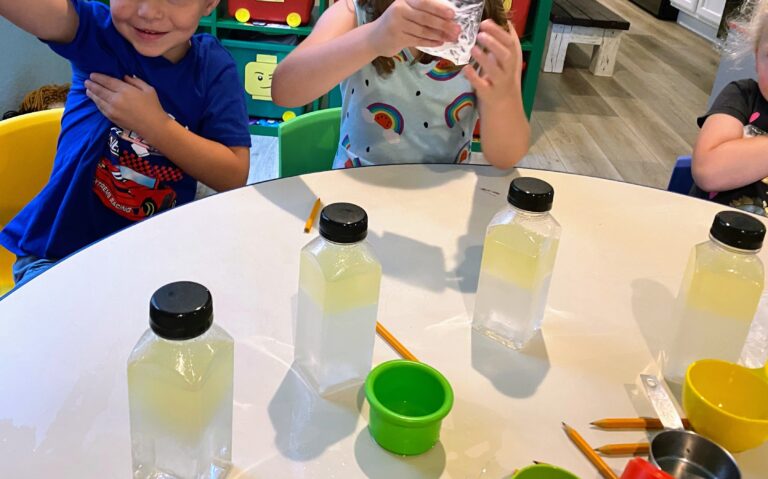For groups wanting Christain inclusion while studying hydrophilic and hydrophobic materials.
Group STEM Activities
- Graduated Water
- Oil Separate Dance
- Coco-melt
- Mess Made
- Salts and Seltzer
- Seal
Graduated water
“You prepare a table before me in the presence of my enemies; you anoint my head with oil; my cup overflows.”
Psalm 23:5
Add an equal amount of water to start a graduated bottle
PREP: Use masking tape along the height of a 12-20 oz empty juice bottle to make a writeable surface one side. Prepare a towel for overflowing.

HOW: Hand out materials for each child to have a bottle and pencil. Go around with water to aid in filling the 1/4 cup measures. Have the child pour the water into their bottle, using a funnel if necessary. Demonstrate how to mark the level of this first pour on the taped side. Go around with water again filling the measuring cups. Pour into the bottle and mark the water level again until the bottles are about 3/4 full.
- juice bottles (straight-walled)
- masking tape
- pencils
- 1/4 cup measuring cup
- funnel
- water
Finally, fill the remaining 1/4 of space with oil, cautioning against shaking. It’s best to wait to hand out bottle lids. Observe where the oil and water meet.
- vegetable oil
Oil Separate Dance
Use gross motor STEM learning to dance the molecular difference between oil and water
HOW: Let any shaken bottles settle out during the next activities. Introduce the two dance moves
- The nature of water, elbows sticking out bouncing around like two hydrogen atoms.
- The nature of oil, elbows tucked to sides with fists up by shoulers, jumping straight up and down life a stiff molecule of fat/oil.
Turn on a music player of the chicken dance and start first 2 water and oil moves. Dance the traditional moves after the “do-do-do-do-do-do, we want more…” swinging around each other’s interlocked elbows.
- chicken dance recording
Coco-melt
“And you shall make of these a sacred anointing oil blended as by the perfumer; it shall be a holy anointing oil.” Exodus 30:25
PREP: Use 4 oz plastic zip baggies and a tablespoon to measure coconut oil into individual packages. Check out @sciencefairyco How-to on Instagram for exact instructions. Fold a piece of packing tape over to double-close the top.

HOW: Make sure the baggies of coconut oil are a warm-room-temperature. Hand out the baggies to each child. Brainstorm with them how to warm the oil to the goal of liquid inside. Begin to ask the differences between the 2 oil types, color, smell, liquidness.
- 4 oz baggies
- coconut oil
- tablespoon
- packing tape
- scissors
Mess made
but the wise took flasks of oil with their lamps
Mathhew 25:4
Observe adding layers to the polar and nonpolar mixture
HOW: Bring the coconut oil out by snipping the corner of the now melted baggie. Add one mix-in, food coloring (4 drops) or glitter (1/2 tsp). Observe movement through the layers while avoiding shaking.
- DIY previous Oil and Water bottles
- food coloring or glitter
Salts and seltzer
And they cast out many demons and annointed with oil many who were sick and healed them.
Mark 6:13
Create sinking and bubbling effect in the bottle
HOW: Use a 1/2 teaspoon to measure course salt into the bottle while looking at the oil-water layer. Repeat this up to 3 times. Ideally with an unshaken bottle from previous, add 1/2 tablet of Alka-seltzer and observe.
The mystery is that the mass of course salt pulls oil with it downward into the water until the salt dissolves into the water and the oil returns up to where it is happy being hydrophobic. The seltzer produces CO2 when it contacts the water below. Those bubbles disrupt the oil layer and pull the oil into the water layer until the oil globs return to their happy hydrophobic zone.

Oil Water and Salt are the smallest wonders of creation. That handiwork underscores most of chemistry and biology.


